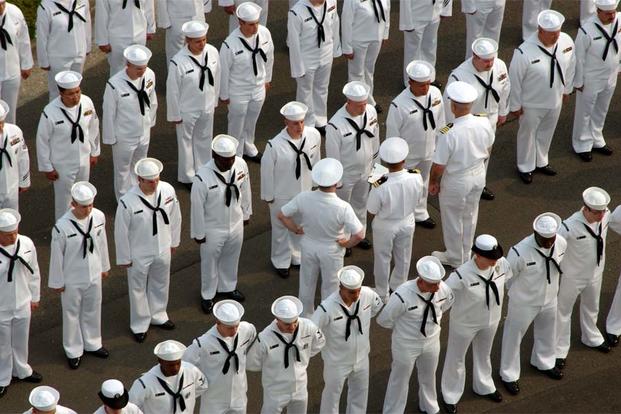When the Marine Corps grows, the Navy has to grow too. That's part of the reason the service requested funding for an extra 4,000 active-duty sailors in the fiscal 2018 budget request, released last week. The Navy wants to increase from roughly 324,000 active-duty sailors to an end-strength of 327,900, with most of the requested growth in the enlisted ranks.
Much of the growth will serve the overall Navy goal of restoring force readiness ahead of the start of a planned ship build-up next year. Officials told Military.com that much of the additional manpower would simply replace sailors who weren't able to conduct regular duties for a variety of reasons.
The Navy wants about 2,000 sailors for individual augmentees and to account for personnel listed as transients, patients, prisoners, and holdees, or TPPH, Rear Adm. Brian Luther, director of the Navy's Fiscal Management Branch, told Military.com during a briefing at the Pentagon.
Having the extra manpower will help the Navy to "get sailors to their ships on time," he said.
The planned Marine Corps plus-up from 182,00 to 185,000 Marines will also require the Navy to add personnel. Navy corpsmen deploy with Marine Corps units to provide medical aid, and Navy chaplains and religious programmers attend to their spiritual needs. In all, Luther said, 163 additional sailors will be needed for that mission.
Another 1,000 sailors will be needed to man Navy Ticonderoga-class cruisers as the class completes a modernization period.
The Navy initially proposed taking half its cruisers offline at once for planned service-life extension maintenance and modernization, a plan that would dramatically reduce the manpower needed to crew the cruiser fleet. But Congress disagreed, passing legislation requiring the Navy to modernize cruisers at the rate of two per year, with no more than six out of circulation at a time.
The extra sailors in the Navy's budget request will allow the service to man cruisers in compliance with the congressional mandate.
The Navy is also requesting a plus-up to enable its new littoral combat ship crewing strategy, introduced last year.
As part of a sweeping range of changes to the LCS program designed to address a series of engineering casualties, improve training, and get the most out of the ship class, Naval Surface Forces Commander Vice Adm. Tom Rowden announced that the ships would leave behind the concept of three crews for two ships and embrace a blue/gold crewing model instead. This model, used on Navy submarines, would allow crews to get to know the ships better, officials said at the time.
In all, the blue-and-gold LCS concept will require 450 additional sailors, Luther said.
An additional 373 sailors will be required as the Navy approaches initial operational capability for its carrier-variant F-35C, Luther said.
The F-35C, which is equipped with a tailhook and larger wings for launching and recovering from aircraft carriers, is the last of the three Joint Strike Fighter variants to reach the IOC milestone, and is expected to do so between August 2018 and February 2019. As new squadrons come online, they require not only pilots but also maintenance personnel and other staff associated with IOC efforts.
Finally, the Navy is asking for 100 sailors to man the expeditionary transfer dock Herschel "Woody" Williams, a seabasing platform set to enter service in 2018, and reportedly planned to operate in the Pacific.
In total, the number adds to 4,086 sailors. Like next year's proposed shipbuilding plan, the planned end strength increase will do little to add to the Navy's operating capacity, but may allow the service to accomplish its current missions better and more smoothly.
"The guidance was, fix, fill the holes for '18," Luther said.
The budget request now goes to Congress for debate. There it faces an uphill battle to passage amid partisan disagreement and unresolved issues pertaining to cuts mandated by the Budget Control Act.
-- Hope Hodge Seck can be reached at hope.seck@military.com. Follow her on Twitter at @HopeSeck.




























